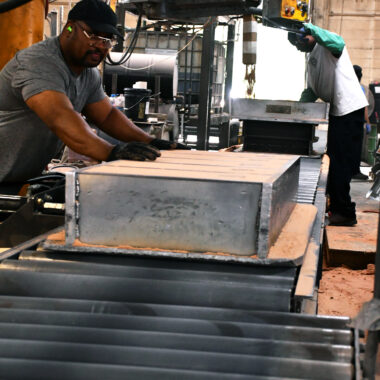Optimizing Efficiency: Let Loose the Power of Aluminum Casting for Superior Products
Optimizing Efficiency: Let Loose the Power of Aluminum Casting for Superior Products
Blog Article
Study the Globe of Aluminum Spreading: Recognizing the Various Techniques
Aluminum spreading is a fundamental procedure in the production industry, with different approaches utilized to produce intricate and exact components. From the typical sand spreading method to the advanced die casting procedure, each approach supplies distinct benefits depending on the requirements of the project.
Sand Casting Method
Sand casting, a widely-used approach in light weight aluminum casting processes, involves creating mold and mildews made of compressed sand for putting molten metal. Once the mold is ready, it is firmly positioned in a flask and molten light weight aluminum is poured into the dental caries.
After the steel has actually cooled and solidified, the sand mold is escaped to disclose the aluminum casting. Sand spreading permits the manufacturing of complicated shapes and large components that might be difficult or costly to produce utilizing various other methods. It is additionally a sustainable strategy as the sand can be recycled and made use of numerous times, minimizing waste in the casting procedure.
Long-term Mold Method

One significant advantage of the Irreversible Mold And Mildew Strategy is the improved dimensional precision it provides. The metal mold permits tighter resistances and finer information in the final light weight aluminum castings contrasted to sand casting approaches. This precision makes it a favored choice for applications where tight dimensional control is important, such as in the aerospace and automotive markets.

Pass Away Casting Refine

Financial Investment Casting Strategy
Making use of an accuracy spreading technique, Investment Casting Method involves creating detailed light weight aluminum elements by pouring molten steel right into a ceramic mold. This process, also referred to as lost-wax spreading, begins with the creation of a wax pattern of the desired component. This wax pattern is after that coated with a ceramic material to form a covering. When the ceramic shell is hardened, it is warmed to eliminate the wax, leaving behind a hollow ceramic mold.
Financial investment casting is frequently made use of for manufacturing elements in sectors where intricate styles and limited resistances are called for, such as aerospace, automotive, and medical devices. The versatility and accuracy of the Investment Casting Method make it a valuable technique in the globe of light weight aluminum casting.
Lost Foam Spreading Technique
Having actually checked out the complex precision of Investment Casting Approach, the emphasis currently changes to the ingenious technique a knockout post of Lost Foam Casting in aluminum part production. Lost Foam Spreading, likewise known as evaporative pattern casting, is a modern-day strategy where a foam pattern of the preferred component is produced and then coated with a refractory product.
Additionally, Lost Foam Spreading is a cost-effective procedure as it reduces the requirement for cores and allows for the manufacturing of lightweight parts. Despite its benefits, Lost Foam Casting needs mindful control of the go casting procedure to prevent flaws and ensure top quality components.
Final Thought
Finally, aluminum casting supplies a variety of techniques such as sand spreading, permanent mold method, pass away spreading, investment casting, and shed foam spreading. Each method has its own advantages and applications, making light weight aluminum casting a functional and widely utilized procedure in numerous sectors. Understanding the differences between these techniques is critical in selecting the most appropriate spreading technique for certain manufacturing needs.
Sand spreading, a widely-used method in aluminum casting processes, involves creating molds made of compacted sand for pouring molten metal. aluminum casting.The Long-term Mold Method, like sand casting, is one more common technique utilized in aluminum casting processes, providing distinct advantages in terms of mold reusability and dimensional accuracy. The steel mold and mildew enables for tighter tolerances and finer information in the final aluminum castings contrasted to sand spreading approaches. The 2 primary kinds of die casting are cold chamber die casting and warm chamber pass away spreading, each appropriate for different types of light weight aluminum alloys.In verdict, light weight aluminum casting provides a variety of methods such as sand spreading, irreversible mold and mildew method, die spreading, financial investment casting, and lost foam spreading
Report this page